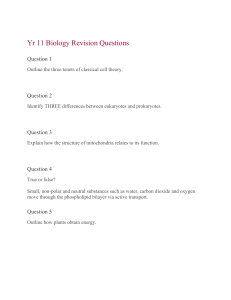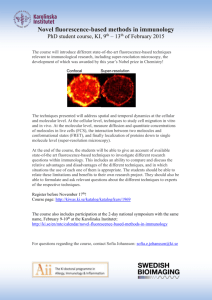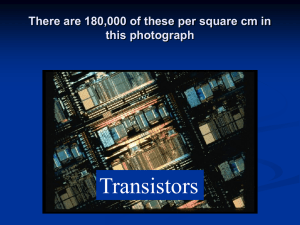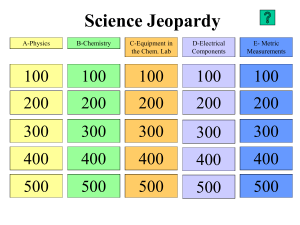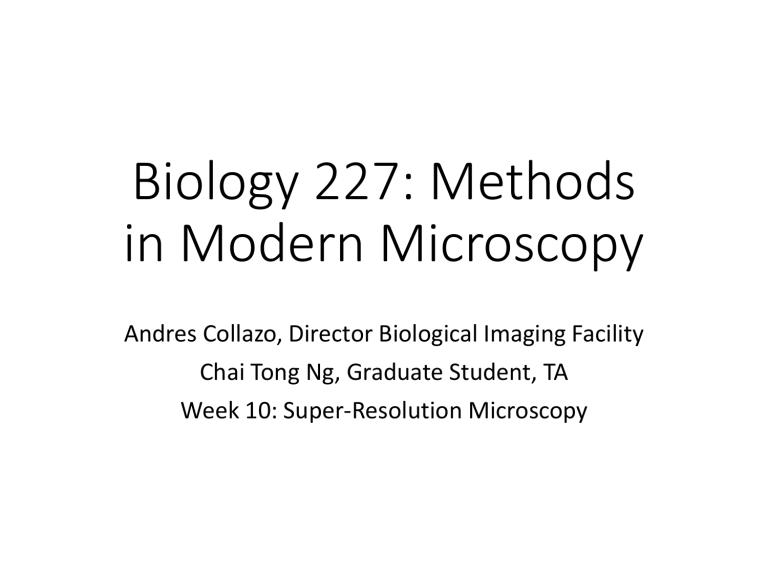
Biology 227: Methods in Modern Microscopy Andres Collazo, Director Biological Imaging Facility Chai Tong Ng, Graduate Student, TA Week 10: Super-Resolution Microscopy Spatial Resolution of Biological Imaging Techniques • Resolution is diffraction limited. • Abbe (1873) reported that smallest resolvable distance between two points (d) using a conventional microscope may never be smaller than half the wavelength of the imaging light (~200 nm) Ernst Abbe (1840-1905) Super-resolution microscopy • Many ways to achieve • Some more super than others. Super-resolution microscopy • Could always do super-resolution if could label points with different colors • Separate with different fluorescent filters (spectral unmixing) • Why fluorescence is such an important illumination technique Hell, S.W., 2009. Microscopy and its focal switch. Nat Meth 6, 24-32. Spatial Resolution of Biological Imaging Techniques Super-resolution microscopy 1. “True” super-resolution techniques • Subwavelength imaging • Capture information in evanescent waves 2. “Functional” super-resolution techniques 1. Deterministic • Exploit nonlinear responses of fluorophores 2. Stochastic • Exploit the complex temporal behaviors of fluorophores Spatial Resolution of Biological Imaging Techniques “True” super-resolution “Functional” “Functional” super-resolution techniques 1. Deterministic • Reversible Saturable (or Switchable) OpticaL Fluorescence Transitions (RESOLFT) • STimulated Emission Depletion (STED) • Ground State Depletion (GSD) 2. Stochastic • STochastic Optical Reconstruction Microscopy (STORM) • Photo Activated Localization Microscopy (PALM) • Fluorescence Photo-Activation Localization Microscopy (FPALM) Reversible Saturable (or Switchable) Optical Fluorescence Transitions (RESOLFT) Includes • STED • GSD STED: STimulated Emission Depletion http://zeiss-campus.magnet.fsu.edu STED Microscopy means scanning a smaller focal spot across the sample Point Spread Function: Confocal vs STED measured with fluorescent nanoparticles under the same conditions Typical lateral (X-Y) resolution in a Confocal: 200x200 nm y x x Confocal Profile 0 200 Typical lateral (X-Y) FWHM (Full Width Half Maximum) in STED is 90x90 nm y 400 600 x / nm STED z resolution is confocal (500 nm) STED Profile 800 1000 0 200 400 600 x / nm 800 1000 STED enables separation of structures even smaller than its FWHM due to the sharp peak. Actual resolution is in the order of 70 nm for raw data (without deconvolution) “Functional” super-resolution techniques 1. Deterministic • Reversible Saturable (or Switchable) OpticaL Fluorescence Transitions (RESOLFT) • STimulated Emission Depletion (STED) • Ground State Depletion (GSD) 2. Stochastic • STochastic Optical Reconstruction Microscopy (STORM) • Photo Activated Localization Microscopy (PALM) • Fluorescence Photo-Activation Localization Microscopy (FPALM) Single-molecule localization (SML) microscopy Stochastic functional techniques Single-molecule localization microscopy Stochastic functional techniques • STED vs STORM • How STORM works Single-molecule localization microscopy • Must have sufficient density of molecules being localized Each super-resolution techniques have pluses and minuses but all methods are improving Schermelleh, L., Heintzmann, R., Leonhardt, H., 2010. A guide to super-resolution fluorescence microscopy. The Journal of Cell Biology 190, 165-175. Super-resolution requirements • High power lasers • Special fluorophores • Concentration of fluorophores • Special optics • Computational processing • Fast detectors • Sensitive detectors • Precise X,Y,Z positioning Super-resolution microscopy • Functional superresolution techniques won Nobel • SIM did not win • SIM not considered to be super-resolution Structured Illumination Microscopy (SIM) Option for wide-field microscope Zeiss Apotome 2 Keyence BZ-X700 Structured Illumination - The Contrast is the Key No visible grid out of focus light Position 1 Position 2 Position 3 Visible grid structures in focus I p ( x, y ) Carl Zeiss Microscopy - ApoTome.2 I1 I 2 2 I1 I 3 2 I 2 I 3 2 Optical section How does super-resolution SIM differ from normal SIM? • It’s all due to the number of different gratings • Zeiss Apotome uses 1 grating • Keyence uses up to 2 gratings • For super-resolution Mats Gustafsson found that 3 different grating orientations were required (gratings finer also) Examples of SR-SIM images from Gustafsson 121 nm beads Actin cytoskeleton 3D SR-SIM uses SLM from Gustafsson (2011) MitoTracker Green acquired at 20 sec intervals Schermelleh, L., Heintzmann, R., Leonhardt, H., 2010. A guide to super-resolution fluorescence microscopy. The Journal of Cell Biology 190, 165-175. Zeiss Airyscan yet another means to achieve super-resolution • Available here at Caltech in the BIF Conventional scanning confocal and the 1 A.u. limit. PH = 1 A.u. is the standard setting for resolution. A point-like emitter generates a diffraction limited pattern (~ PSF) PH = 1 A.u. excitation excitation and detection are scanned in sync detection Intensity scan At 1 A.u. The PSF is mapped directly 1:1 ~ 240 nm scan Carl Zeiss Microscopy 24.08.2022 26 Scanning confocal and the 1 Airy unit pinhole “limit”. At PH < 1 AU signal loss is larger than gain in resolution. The potential to increase resolution by closing the pinhole (PH) is not a new idea (red) One finds this idea described in many places, including Pawley’s Handbook of Confocal Microscopy The price to pay, however, is sacrificing 95% of the signal (green). The famous 1 AU setting is more of a practical barrier than a theoretical limit. Fortunately, now there is a clever workaround with Airyscan... Carl Zeiss Microscopy 24.08.2022 27 Airyscan: PH ~ 0.2 A.u. scanning without loss. A single element improves resolution PH = 0.2 a.u. A point-like emitter generates a diffraction limited pattern (~ PSF) excitation By collecting just the central element the PSF is weaker but smaller detection Intensity scan ~170nm scan Carl Zeiss Microscopy 24.08.2022 28 Airyscan Detection Unique 32 GaAsP-PMT design LSM 880 output port Replaced with New Design filter wheel Y adaptive zoom optics 32 GaAsP-PMT array X Carl Zeiss Microscopy 24.08.2022 29 Airyscan: PH ~ 0.2 A.u. scanning without loss. A single element improves resolution PH = 1,25 a.u. A point-like emitter generates a diffraction limited pattern (~ PSF) excitation By collecting just the central element the PSF is weaker but smaller detection subunit ~ 0.2 A.u. Intensity scan ~170nm scan Carl Zeiss Microscopy 24.08.2022 30 Airyscan: PH ~ 0.2 A.u. scanning without loss. A single element – even if offset still improves resolution PH = 1,25 a.u. A point-like emitter generates a diffraction limited pattern (~ PSF) excitation By using an element offset from the center, resolution is still improved detection subunit ~ 0.2 A.u. Intensity scan scan Carl Zeiss Microscopy 24.08.2022 31 Airyscan: PH ~ 0.2 A.u. scanning without loss. Combining the data PH = 1,25 a.u. Image formation: 1 = Offset signal 2 = Add signal excitation detection subunit ~ 0.2 A.u. Intensity scan scan Carl Zeiss Microscopy 24.08.2022 32 Airyscan: PH ~ 0.2 A.u. scanning without loss. With 32 detectors all photons are recorded and mapped at the same time PH = 1,25 a.u. excitation All elements are acquired simultaneously, and can be remapped for better resolution and sensitivity The PSF is mapped directly 1:√2 detection Intensity subunit ~ 0.2 A.u. ~ 140 nm Get an extra push beyond the limit using deconvolution (down to 1:1,7) scan Carl Zeiss Microscopy 24.08.2022 33 TQFR survey • Teaching Quality Feedback Report (TQFR) survey period for WI 2017-18 will open today Monday, March 5, 2018 • Link is here: https://access.caltech.edu/tqfr/taker/queue
